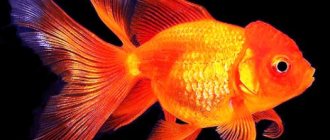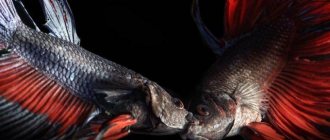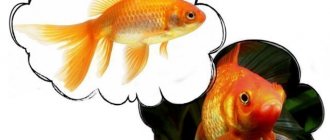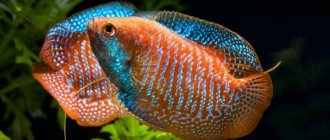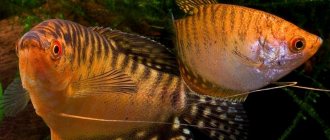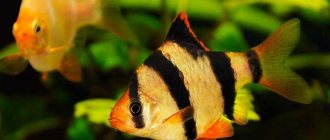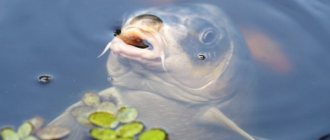Goldfish are the most popular inhabitants of aquariums. Beginner aquarists, as a rule, give these graceful beauties a priority role when choosing aquatic pets. However, further settlement of the water area must be carried out taking into account the interests of goldfish and focusing on the possibility of comfortable living together in one container. A lot of research and observations carried out since the Middle Ages make it possible to select neighbors for these beautiful creatures with whom they can live happily.
Characteristics of goldfish
Goldfish (lat. Carassius auratus) are undemanding in care, lead a calm, measured life, leisurely swimming in the aquarium space. The temperament of each individual depends on the type of fish, as well as its size. The larger the representative of the family, the less active and sluggish she is. Fish such as ryukin, pearl, telescope, oranda are extremely phlegmatic and simply cannot dodge their nimble neighbors, and their beautiful veil-like fins and tails will be mercilessly bitten off.
Keeping and caring for goldfish is not difficult even for a novice aquarist
Golden beauties are lovers of food, they are constantly in search of something edible. Even inedible objects are sometimes swallowed as food. Therefore, small representatives of aquafauna can easily become food for these gluttons.
Because of their immaturity, Carassius auratus remains constantly hungry next to its more nimble neighbors. However, as well as vice versa, voracious beauties absorb all the food, depriving their slow-moving cohabitants.
In search of food, goldfish dig up the aquarium soil, raising dirt and turbidity from it. Therefore, lovers of clean, clear water, as well as bottom inhabitants, are absolutely not suitable for them as neighbors.
Goldfish are unpretentious when choosing food; live, frozen or dry food is suitable.
Goldfish are unpretentious eaters and have an enviable appetite.
The diet of all neighbors should be the same. In addition, cohabitants must have the same temperature regime.
Goldenflowers are conventionally divided into long-bodied and short-bodied representatives. Long-bodied ones (comet, shubunkin, wakin) have a body shape that is closest to the original natural one, so they are faster and more active. Their cohabitation with short-bodied animals (telescope, veiltail, oranda, nymph, ryukin, butterfly, jikin, tosakin, nankin, pompom, ranchu, etc.) is undesirable due to the sluggish and slow temperament of the latter. Such a difference in character will lead to civil strife.
History of appearance/discovery
The history of the discovery and appearance of neon in hobby aquariums is closely connected with the French explorer and adventurer Auguste Rabot. It was he who first discovered small luminous fish in the Putumayo River (Peru). He was simply mesmerized by the beauty of these creatures and decided that he could earn a lot of money by exporting such a miracle. In 1935, the first copies of neon were sent to the United States of America and Europe. Aquarists of that time really liked the fish, the demand for it skyrocketed, and now Rabo is already becoming the world's only supplier of neon to the Old and New Worlds. For a long time it was not possible to breed neons in captivity, so the monopoly lasted for a relatively long time. One of the first copies was donated for advertising purposes to William Innesi, an amateur and popularizer of aquarium keeping. He, in turn, gave the fish to his friend George Myers, who made the first scientific description of a new species - blue, or ordinary neon, which he named in honor of his friend Hyphessobrycon innesi. The species later changed its name to Paracheirodon innesi.
Red neon (Paracheirodon axelrodi) was discovered only in the middle of the 20th century. The descriptions were made in parallel by two scientists - Myers and Schultz. But the latter published his work earlier, so the name he gave to the fish in honor of his friend the aquarist Herbert Axelrod was fixed in the nomenclature.
In 1963, Jacques Gehry discovered another type of neon - emerald neon, or simulant neon. The sample he caught was very similar to the red neon, but his further study led to the identification of these fish as a separate species. Gehry also carried out a systematic revision of neons and assigned them to the genus Paracheirodon, which is how they are called to this day.
For the first time, it was possible to obtain offspring from neons in captivity in Germany. This happened by a happy coincidence, and was due to the fact that this country has very soft water, which was used to contain neons. At the beginning, the spawning of neons was called a “German miracle,” but the first studies revealed the mechanisms of the influence of water parameters on the reproduction of these fish. From now on, neons become available to all aquarists in the world.
Nowadays, fish are grown en masse on special farms in Southeast Asia. Although occasionally there are also deliveries of wild neons caught in the natural environment.
Compatibility table
All representatives belonging to goldfish are incredibly beautiful. It is not surprising that their owners want to house several different species in one home. You can determine the possibility of adding a particular individual using a table that will tell you about the compatibility of pets.
| Fish name | Compatibility with Carassius auratus | ||
| Compatible | Conditionally compatible | Absolutely incompatible | |
| Angelfish | X | ||
| Barbs | X | ||
| Cockerels | X | ||
| African aquarium fish cichlids | X | ||
| American cichlids | X | ||
| Catfish cockroaches | X | ||
| Soma Corydoras | X | ||
| Danio | X | ||
| Guppy | X | ||
| Gourami | X | ||
| Goldfish | X | ||
| Koi carp | X | ||
| Neon | X | ||
| Mollies | X | ||
| Rasbory | X | ||
| Rainbows | X | ||
| Labeo | X | ||
| Swordtails | X | ||
| Shrimps | X | ||
| Tetras | X | ||
| Discus | X | ||
| Botsiya | X | ||
| Akara | X | ||
| Ancistrus | X | ||
| Astronotus | X | ||
| Lyalius | X | ||
| Macropod | X | ||
| Melanochromis | X | ||
| Tropheus | X | ||
| Pecilia | X | ||
| Pristella | X | ||
| Nothobranchus | X | ||
In addition, pay attention to population density. For example, in one 100 liter aquarium it is allowed to contain no more than 2 scrofula. To determine the number of other fish, use a special calculator.
Spawning
In a spawning aquarium (preferably with a volume of at least 2-3 liters), a bunch of Java moss or nylon threads are placed as a substrate and a safety net is installed so that the swept eggs are inaccessible to producers who would not mind eating them.
The lighting is weak - a 15 W bulb connected at full intensity. After spawning, the aquarium is shaded. The larvae are afraid of light, hatch after 24 hours, and on the fifth day they begin to swim normally and feed on the smallest plankton.
What fish do they get along with?
There are breeds with which goldfish get along the easiest.
Other breeds of goldfish
A species aquarium is the best solution for keeping Carassius auratus.
All breeds of goldfish are absolutely compatible in all respects: temperature, temperament and nutrition. However, nuances are taken into account here. It is better not to place short-bodied individuals in the same container with long-bodied ones due to their different characters. Long-bodied scrofulas are, as a rule, somewhat faster than long-tailed beauties.
It is not recommended to place long-bodied and short-bodied goldfish in the same aquarium.
Also, different-sex fish of different breeds cannot be placed in the same aquarium. Since all goldfish are bred through selection from silver crucian carp, various subspecies will begin to interbreed with each other, thereby reproducing mutating offspring - hybrids, in which species characteristics will be lost.
Ultimately, such a mutation will lead to the degeneration of the species and the transformation of scrofula back into crucian carp.
Koi carp
A friendly neighborhood would be the cohabitation of goldfish and koi carp. Both of them belong to the carp family, only the ancestor of which is the carp, and the ancestor of Carassius auratus is the crucian carp. Therefore, when they cohabit, crossing cannot occur.
Koi carps come from the same family as goldfish.
Koi carp are often called goldfish because of their golden, bright color. Calm, even-tempered koi have a similar personality to goldfish and cannot harm them. Even their habits are the same - they also prefer to dig in the ground, raising mud from it.
There is only one minus. Koi carps grow up to 70 cm and are best placed in a pond. Purchasing an aquarium of the appropriate size is problematic, given that there must be at least 5 liters of water per 1 cm of body. Although many scrofula live well in pond water.
Corridors
Corydoras catfish will also serve as excellent peaceful neighbors for goldfish. Their temperature regimes are completely the same. Both prefer cool water no higher than 25 degrees.
Corydoras are excellent neighbors for goldfish
Corydoras live in groups, lead a bottom lifestyle, collecting leftover food and waste from the bottom of the aquarium, of which Carassius auratus leaves a lot.
The only drawback in their neighborhood is that Corydoras are very slow, which may not please the main owner of the aquarium.
Tarakatums
Corydoras' cousins, the Tarakatum catfish, also get along well with goldfish in the same area. These representatives of the underwater world lead completely different lifestyles, so they practically do not overlap in the aquarium.
Tarakatums can live peacefully with goldfish
General information
Aquarists value neons very much not only for their ability to get along with most species in a common aquarium, but also for the unusual coloring of these underwater inhabitants. A distinctive feature of all neons is the presence of a special shiny strip along the body, which flashes like a light in reflected light. It is so bright that it resembles the lights of neon advertisements in the city at night. This is why the fish got its name.
Neons often become the main inhabitants of aquarium landscapes - aquascapes.
Aquascape with blue neons
Professional designers are very fond of neons for their small size, which does not distract from the main picture, activity, which gives liveliness to the entire design, and indifference to plants, which will retain their shape and beauty. The flocks of neons themselves look very impressive against the backdrop of dense green vegetation.
The question of why the small, defenseless neon fish needs such a bright color remains unanswered. Perhaps this is necessary to establish a hierarchy in the flock, perhaps it confuses predators who decide to attack a flock of neons. There is a theory that such light effects allow neons to find each other in darkened water conditions, characteristic of typical biotopes. Some aquarists believe that neons are capable of glowing on their own, but, unfortunately, this is a misconception: neon strips only reflect and refract the light rays falling on them.
Keeping neons in a home aquarium will not be difficult, the main thing is to create optimal water parameters for the fish, regularly maintain the aquarium and feed it with high-quality food.
Acceptable Content
Keeping with the following types of fish is quite acceptable.
Mollies
Large mollies are also introduced to Carassius auratus. As an edible object, they are not suitable in size, and the mollies themselves are indifferent to the fins of other fish.
Mollies
Gourami
Gourami
Neighborhood with gourami is quite possible. These are non-aggressive labyrinth fish with habitat parameters similar to Carassius auratus.
However, among the peace-loving gourami there are warlike individuals, the proximity of which will not bring anything good to the scrofula.
Tetras
With young small goldfish, it is quite possible to place a peace-loving tetra, which belongs to the family of characin fish. However, it can become easy prey for large adults, who eat everything that fits into their mouth. The same applies to other miniature characins. Neons, rhodostomuses, minors are too small neighbors that will certainly become the object of food for scrofula.
Tetras and scrofula are fully compatible
If we talk about other characin fish, then it will be successful to be in proximity to large specimens of thorns or congo fish.
However, you should not forget about the temperature regime. Most aquarium inhabitants, especially tropical species, require warm water of about 25 degrees, while golden carp are cold-water creatures.
Danio
A similar situation, as with tetras, arises if zebrafish are placed in the same dwelling. With small goldfish, aquarium zebras will exist peacefully. Both species prefer the same temperature regime; zebrafish are indifferent to other people's fins and do not fight for food. However, for larger representatives, zebrafish will become prey.
Danios will coexist peacefully with goldfish
Carassius auratus is compatible in temperament and temperature with all bottom-dwelling fish and catfish (acanthophalmus, botia, corydoras, ancistrus, cockroach, etc.). But some catfish behave aggressively, for example, bots. It would seem that the calm botia has a similar character to the golden mistress. These beautiful, colorful creatures also prefer to peacefully swarm in the ground, rest in the grass or under snags, and swim peacefully in a school in an aquarium environment. However, they will not mind feasting on the tempting fins of goldfish.
And such an aquarium resident as Ancistrus is a nocturnal lover of clinging to other sleeping neighbors and spoiling their appearance. From such cohabitation, the golden beauties will soon take on a shabby appearance.
Relatively compatible species
Barbs
The main problem with keeping Barbs and Neons together is the difference in temperament. The barbs constantly scurrying back and forth create a little stress for the calmer neons. This problem is especially acute in small aquariums, where fish constantly meet each other.
Angelfish
For the cohabitation of neons and angelfish to be successful, it is best to keep the fish together from a young age. In such a situation, angelfish do not show aggression towards small characins. But it will most likely not be possible to add new neons to adult angelfish; there is a high probability that the small fish will be overrun by angelfish.
Marbled gourami
Even despite their size, gouramis have a rather peaceful disposition. However, sometimes they are able to attack small fish, especially shiny ones like neons. Keeping these species together requires control, and it is better if the fish live together from childhood.
With whom sharing is contraindicated?
It is better not to mix goldfish with the following types of fish, as this may end badly for them.
Barbs
Barb hunters will not leave the veil-like fins of goldfish alone until they turn into stubs. Therefore, cohabitation of these fish is contraindicated.
It is strictly forbidden to keep goldfish with barbs.
Guppy
Guppies are too tiny aquarium inhabitants, so they will definitely become prey for golden goblets. Even by young individuals, the lush tails of guppies will certainly be plucked. In addition, these fish prefer completely different temperature conditions.
Angelfish
Angelfish, which belong to the aggressive breeds of fish, will not give the phlegmatic goldfish rest; they will chase them, biting their tail and fins. In addition, these aquarium inhabitants are accustomed to different temperature environments. Therefore, the proximity of these fish is unacceptable.
Aquarium fish angelfish
African cichlids
Guppy fish
African cichlids
African cichlids are ardent defenders of territory; they will not give rest to the golden inhabitants and will constantly try to attack them in order to drive them away from their territory. Therefore, such cohabitation is excluded.
American cichlids
Any species of cichlids are large fish, native to tropical latitudes, preferring warm southern waters. Goldfish are descendants of common crucian carp that live in temperate climates. Absolutely different temperature conditions do not allow keeping these representatives of aquafauna in the same dwelling. In addition, American cichlids are aggressive predators, for which Carassius auratus will be easy prey.
American cichlids are undesirable neighbors for goldfish
All representatives of the cichlid family are very aggressive predators. Astronotus is particularly hostile, for which golden carp will become a tasty prey. Therefore, goldfish cannot be kept with any representative of this family, even the smallest.
Swordtails
These sharp-tailed aquarium inhabitants have a habit of biting the fins of their neighbors, so cohabitation with goldfish will have an unfavorable effect on the latter.
Swordfish
Discus
Discus
Discus fish are heat-loving creatures; they are comfortable swimming in water with a temperature of 30-32 degrees. Goldfish will simply “cook” at such temperatures, so cohabitation of these species is impossible.
Habitat
The birthplace of neon is South America. It is here, in the area of the Paraguay, Rio Tacuari, and Brasil river basins that you can find these amazing fish in their natural habitat. Neons do not like fast flows and prefer to live in slow-flowing tributaries of large rivers, the waters of which are rich in humic substances, which gives them a brown tint. These rivers usually flow under the canopy of a tropical rainforest, creating a semi-darkness in the water. Decaying leaves, regular rains, and a large layer of silt make the water soft and acidic.
Can fish eat their neighbors?
As mentioned above, goldfish are omnivorous lovers of any food. This can be live or frozen food, freeze-dried and dry food, and they do not refuse aquarium algae. Miniature fish that live in the neighborhood also become food for goldfish.
Goldfish can eat very small fish
Tiny neons, rhodostomuses, rasboras, and minors can become food for the golden inhabitants. While Carassius auratus is small in size, they get along well with these species. However, for adult individuals, small change will definitely become prey.
Gold gluttons and cockerel fish are no less at risk of becoming food for food. However, being notorious bullies, the cockerels themselves often tug at the goldfish’s fins.
Adviсe
- There are species whose character changes as they grow older. For example, some catfish become territorial.
- Study the information yourself. The advice of others is not always correct. Find more information about your fish.
- The large number of fry and snails is regulated by the settlement of large neighbors.
Fish compatibility is a point that needs to be studied when becoming an aquarist. It is also important to know about fish nutrition, lighting, starting an aquarium and changing water parameters.
Previous
FishSmall peaceful cuneiform rasbora
Next
Fishes Find out how long betta fish live at home
Is it possible to add shrimp?
Given the delicate temperament of golden pets, they can choose not only fish, but also other underwater animals as neighbors. For example, large-sized shrimp, having a character similar to scrofula, will make an excellent tandem.
The shrimp will cleanse the common dwelling from waste products of golden “dirt”, which they produce in large quantities. At the same time, the aquarium will take on an exotic look, especially if you add shrimp of various colors to it. It is important that they are not small and cannot fit into the mouths of golden gluttons.
Goldfish can get along well with shrimp in the same aquarium
Introduction
Neons received their unusual name for a special wide stripe on the body, which flashes brightly in reflected light, like a night neon advertisement on the street of a large city. For a long time, these brilliant beauties were supplied exclusively from nature and cost incredible amounts of money. But by a lucky chance, the secret of their reproduction was revealed, and now anyone can have a flock of neons in their aquarium, the most popular of which are blue, red and black.
Neons are peaceful fish that get along well with most popular aquarium species. Let's consider the basic rules for the compatibility of neons with other types of fish.
Is it worth introducing other fish at all?
As you can see, the compatibility of goldfish with other types of aquafauna is very weak. Differences in living conditions, as well as temperamental characteristics, can lead to adverse consequences both for Carassius auratus themselves and for their cohabitants.
The best option would still be to design a species aquarium with identical representatives of the aquarium world.
The neighborhood with catfish, tarakatums and corydoras, zebrafish and thorns will also be friendly.
To ensure a favorable neighborhood even with the most peaceful cohabitants, it is better to introduce all living creatures into the aquarium at the same time and at as early an age as possible. You shouldn’t add new neighbors, even to replace those who died. They will be perceived as “strangers” by the goldies.
The introduction of aquatic inhabitants of other species should be carried out as early as possible
What you should pay attention to
Volume
Neons are typical schooling fish that feel uncomfortable alone. And for a flock you need an aquarium of a suitable size. It is best if the capacity is at least 60 liters, and even more for keeping with other species. In a cramped space, the fish will constantly experience stress, but here it is not far from conflicts between neighbors.
Balance in the aquarium
Neons are finicky fish; it is better to keep them in aquariums with an established biological balance. Freshly started aquariums are dangerous for neons due to the instability of water parameters.
Plants
Live plants provide excellent natural cover and help maintain high water quality in the aquarium, so be sure to plant them along the walls of the aquarium. The central part can be left to float freely.
Spawning
Spontaneous spawning of neons is extremely rare. But if all conditions are favorable, the fish can begin to reproduce. During this period, peaceful neons become quite aggressive and can attack neighbors in the aquarium. Therefore, it is better to engage in reproduction in a separate spawning tank.
Source
Content nuances
Keeping goldfish is very easy. But nevertheless, like any pet, they require regular care. It is completely simple, you just need to follow the basic rules.
Golden beauties are large aquarium fish, so their housing must be appropriate in size. A standard cubic aquarium with a volume of at least 50 liters is optimal. If you plan to settle long-bodied breeds (comets, shubunkins), then it is better to purchase a vessel that is more elongated in length so that the pets have room to swim. Accordingly, the more residents are planned, the larger the capacity should be.
A classic rectangular aquarium with a volume of at least 50 liters will be the best choice for goldfish
Overcrowding of a home is dangerous for all inhabitants - in such an aquarium there is a high probability of poisoning with dangerous poisons released during their life.
It is best to place coarse soil, for example, round pebbles, at the bottom of the vessel, so that voracious rummage lovers will not be able to catch small particles in their mouths, choke or swallow them. Objects with sharp edges should not be used for decoration. Slow scrofula can easily get injured by them.
You should not fill the aquarium with chlorinated water; it is not suitable for animals. For dechlorination, special conditioners are purchased, or most often, settled water is used.
As mentioned above, goldfish are terrible dirty creatures that produce large amounts of waste. Therefore, their home must be equipped with a powerful filtration system. At the same time, such a filter should not create a strong flow of water that will carry away clumsy beauties.
For a goldfish aquarium, it is recommended to install a powerful filtration system
In natural conditions, the ancestor of Carassius auratus is the silver crucian carp, which lives in reservoirs with cool, and in winter, even ice-cold water. Therefore, their descendants also prefer cool habitats. The optimal water temperature in the aquarium should be 22-25 degrees, then the pets will be comfortable in it.
Water of any hardness, both slightly alkaline and slightly acidic, is suitable for living. Such endurance was passed on to the beauties from an ancient ancestor - the silver crucian carp.
At least once a week it is necessary to wash the container and interior items in it. To avoid the accumulation of toxic substances in the water after cleaning, replace 15-20% of its volume. To dechlorinate tap water, Tetra AquaSafe is used, a special conditioner that is added to the water before topping up. This drug neutralizes dangerous compounds of chlorine and iron. Add 5 ml of conditioner to 10 liters of water.
Tetra AquaSafe conditioner is necessary to neutralize chlorine and iron compounds in water
Many aquarists prefer to use settled water. However, only dangerous chlorine evaporates from it; heavy metal impurities do not disappear.
To prevent certain diseases, no more than 5-7 g/l of salt can be added to the fish container.
Goldfish are absolutely omnivorous and can be fed with live, frozen, or freeze-dried dry food. However, you should not get carried away with high-protein foods. Constantly feeding only live and frozen food will lead to gastrointestinal problems. It is better to use specialized feed that contains in balance all the necessary nutrients, trace elements and vitamins. It is better to feed in small portions, adding pinches of food.
It is recommended to feed goldfish with specialized food
Scrofula is prone to overeating, which will have a detrimental effect on their health. If the fish has eaten too much, the owner will notice this by the fish swimming on their side.
The majority of the diet should be plant foods (70%). Since Carassius auratus consume food endlessly, live vegetation is suitable for a snack between main meals, which they will happily pluck. By eating greens, fish will not overeat. It is best if it is hard-leaved or fast-growing algae (Anubias, Vallisneria, Cryptocoryne, Elodea). Vegetation must be firmly fixed in the ground or installed in pots. Otherwise, scrofula, stirring the soil, will get to the roots.
The container should be free of any small objects that fish could swallow, be it pebbles, pieces of wood, splinters, etc. If such an object gets into the throat of a fish, then you will have to get it out with tweezers yourself, which is very difficult, given the slipperiness of these creatures.
Scrofula does not require a special lighting regime; an aquarium lamp with a temperature of 6000-6500 is sufficient. Such light will favorably emphasize the color features of aquarium beauties and will not contribute to disruption of the biocenosis in the water.
Aquarium lamps with a color temperature of 6000-6500 K will emphasize the bright colors of the fish and the naturalness of the environment
If any deviations in the behavior of pets are detected (restless swimming, bulging eyes, heavy breathing, or excessive slowness and apathy), it is necessary to find out the cause and help the fish get rid of the disease.
Considering the peculiarities of keeping goldfish, the conclusion arises that a species aquarium is best suited for them. It can be intraspecific, which will contain creatures of only one breed, or interspecific with different subspecies of scrofula. It is important to remember that only individuals of the same sex and with the same body shape are suitable for coexistence.
Have you ever kept goldfish? How difficult is it to care for them? Share your experience in the comments.
Caring for eggs and fry
The development time of eggs is 36−48 hours. During this time, you need to closely monitor her. If whitish eggs begin to appear, they must be removed immediately using tweezers. If you do not do this, they will begin to decompose in the water and eventually destroy all the offspring.
The fry that are born hang motionless on the glass for the first days. After a few days they gradually begin to swim. By day 5, they are already able to move completely independently.
Feeding your offspring is not an easy task. Newborn neons have very poor vision; they can only navigate towards the light source (phototaxis). This property should be used for feeding.
Don't forget to buy food for the fry
They try to darken the entire aquarium, leaving light in only one corner. Infusoria will begin to accumulate in this corner, which the fry will be able to feed on. In this way, it will be possible to preserve all the young that are born. As the fry begin to grow, they are switched to feeding on brine shrimp or rotifers, and then small cyclops. You can buy ready-made food in the store that is designed specifically for fry. Boiled and mashed chicken egg yolk is suitable as food.
The hardness of the water in the spawning tank can be gradually increased. To do this, add a little water from the general aquarium every day. The water temperature should be maintained at 20−22°C. Thorough aeration of the water is required. In this way, the fry are gradually prepared for transfer to a common reservoir.
Reproduction
Although in nature there are no specific conditions (fish do not leave their usual habitat to spawn), in a large aquarium where neons live together with representatives of other species, conditions do not always correspond to reproduction.
To obtain offspring, fish are placed in a container of a smaller volume - optimally 20 - 30 liters, while the water level should be low - 15 - 20 cm. Since there are no other fish in the spawning area except the neons themselves, the eggs should be protected from the producers.
The bottom is covered with a layer of Java moss or a separator net (the second option allows you to track the moment of spawning). The water should be very soft (no more than 2 ° dH) and clean. The light should be dim
Males and females are kept separately from each other for a week, while maintaining a variety of feeds with a predominance of animal nutritional supplements. They are placed in the spawning tank in the evening; often by morning the fish can already spawn. In some cases, the process takes two to three days.
For successful reproduction, there must be two or three males per female. A strictly paired ratio is also possible, but the effectiveness decreases.
After the eggs hatch, adults should be immediately transplanted back into the general aquarium, and the amount of light should be further minimized. A small portion of the water needs to be changed daily. The incubation process is completed within about a day, but the fry acquire the ability to swim only by the fifth day. Then you can start feeding them with the smallest fraction of food - often, but little by little, to prevent the water from becoming cloudy.
Price
| Size, cm | Cost, rubles |
| Fry, up to 2 cm | 40 |
| Teenagers, up to 3 | 60 |
| Young representatives, up to 3.5 | 75 |
| Adult representatives, up to 5 | 90 |
Sources
- https://MrHvost.com/rybki-neony
- https://fanfishka.ru/akvariumnye-tati/902-neony.html
- https://MrHvost.com/krasnyi-neon
- https://rybki.guru/razmnozhenie/rybki-neony.html
- https://aquazhizn.ru/vidy-rybok/krasnyy-neon
- https://catfishes.ru/neon-yarkij-mirnyj-znametnityj/
- https://NashiRybki.ru/rybki/neony-razmnozhenie.html
- https://RybkiVBanke.ru/akvariumnye-rybki/razmnojenie-neonov
- https://RybkiVBanke.ru/akvariumnye-rybki/neony
- https://rybkies.ru/rybki/chernyj-neon.html
[collapse]
Starter feed
“Live dust” is a good starter food. But you can find live food consisting of various ciliates and rotifers only in natural reservoirs, and even then in the spring. In other cases, home culture of slipper ciliates and Artemia crustaceans are used to successfully feed fry.
The fry should be fed with newly hatched nauplii, as after a few hours they will lose their nutritional properties. As the fry grow, the size of the food needs to be increased.
The fish is red neon - almost like an ordinary one. But red
Red neon (lat. Paracheirodon axelrodi) is an incredibly beautiful fish and one of the most popular in the aquarium hobby. He is especially beautiful in a flock, in an aquarium overgrown with plants; such a flock looks simply enchanting. A distinctive feature of red neon is a blue stripe in the middle of the body and a bright red one below it. It is precisely its large red stripe that distinguishes it from its relative - ordinary neon. The fact is that in red neon this stripe goes across the entire lower body, but in ordinary neon it occupies only half of the abdomen, up to the middle. In addition, red neon is much larger.
True, you have to pay for beauty, and red differs from ordinary red because it has higher requirements for living conditions. It is also small in size and peaceful, and can easily become a victim of other large fish. When red neon is kept in soft and acidic water, its color becomes even brighter. It also looks advantageous in a heavily overgrown aquarium with dim lighting and dark soil. If kept in a stable aquarium with good conditions, the red neon will live a long time and resist disease well. But, if the aquarium is unstable, it dies very quickly. In addition, like ordinary neon, red is susceptible to a disease - neon disease. With it, its color sharply turns pale, the fish loses weight and dies. Unfortunately, neon disease has no cure.
Habitat in nature
Description
Difficulty in content
Feeding
Keeping in an aquarium
Compatibility with other fish
A peaceful fish that, like other tetras, needs company. It is better to keep a flock of 15 or more, this is how they will look the brightest and feel most comfortable. Well suited for community aquariums, provided that the water parameters are stable and the neighbors are peaceful. Good neighbors would be black neons, erythrozonus, pristella, and tetra von rio.
Sex differences
catfishes.ru>
Description
This is a small and slender fish. Aquarium fish blue neons grow up to 4 cm in length and they live for about 3-4 years. As a rule, you don’t notice their death, it’s just that the flock gets smaller and smaller year after year.
Neon is distinguished primarily by a bright blue stripe running across the entire body, which makes it very noticeable. And in contrast to it, there is a bright red stripe, which starts from the middle of the body and goes to the tail, slightly extending onto it. What can I say? Easier to see.
